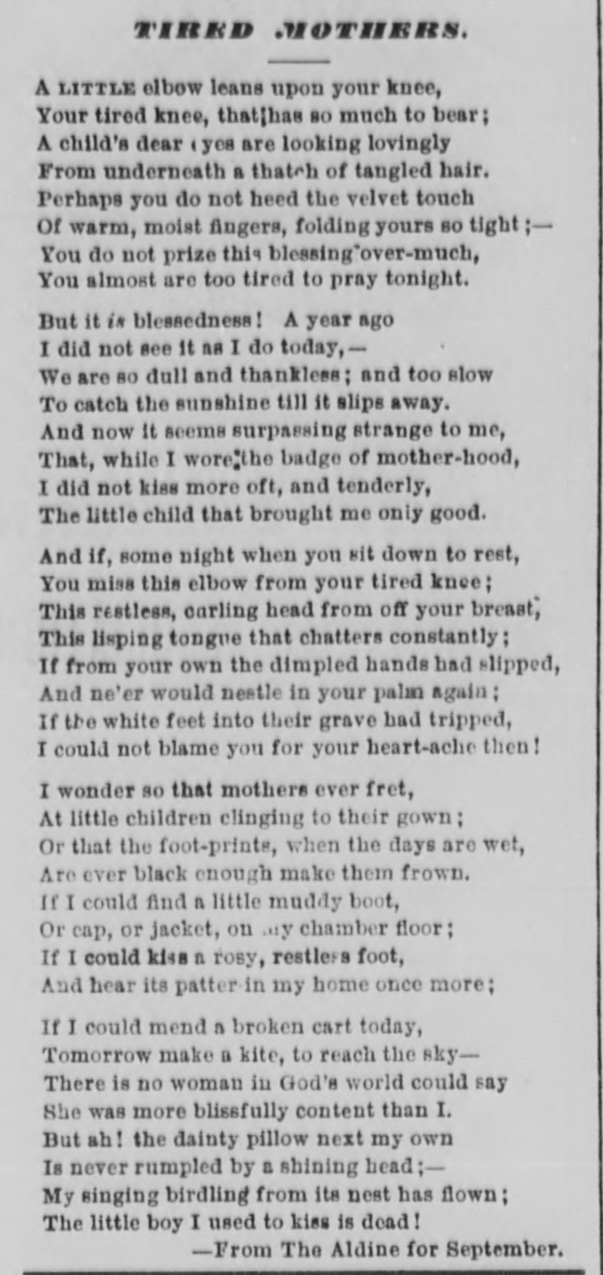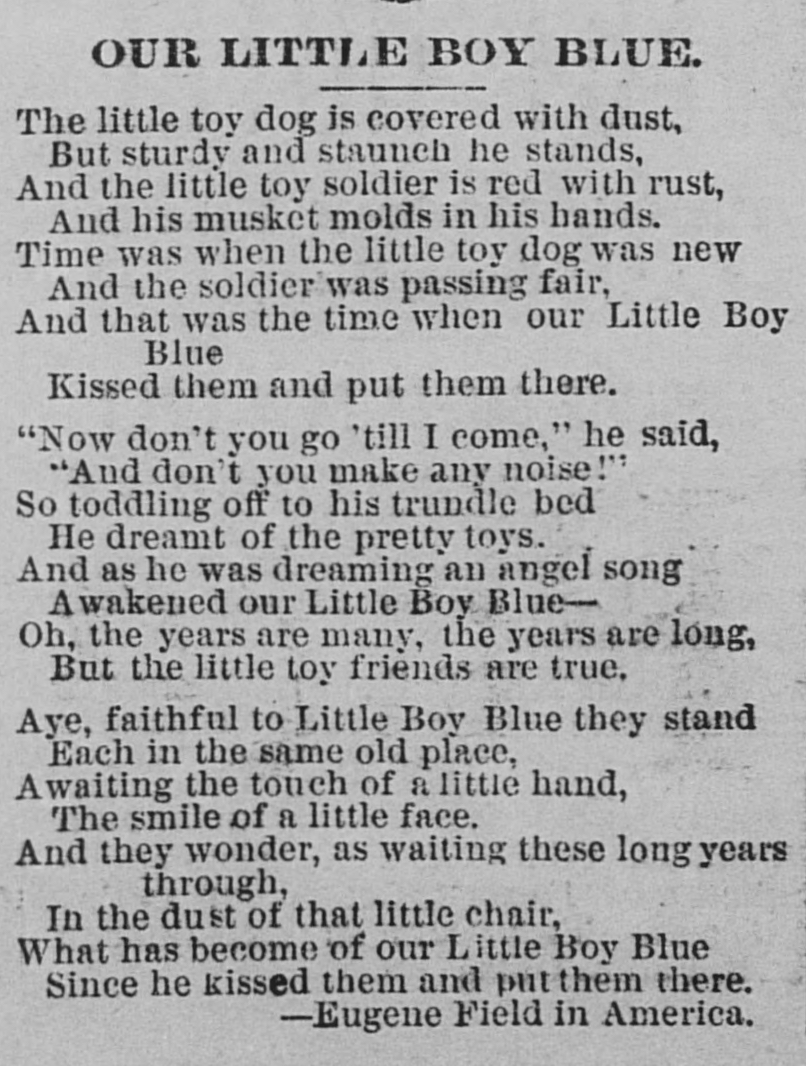The Sentiment of Circulation
Below is the paper I will deliver at the 2017 Modern Language Association Convention in Philadelphia, as part of the panel “#AllTheFeels: Sentimentalism Then and Now.” I have not included the slides but have included links, embedded video, and images that should give blog readers a clear sense of what I’m talking about in each section of the talk.
Let’s begin with a short video, an advertisement for the Polish online auction website Allegro—think eBay—that circulated around the international web about one month ago. As of this past Saturday, it had been viewed more than 13.2 million times on YouTube.
I came across this video in the Facebook feed of a friend who regularly posts a “Weepy of the Day.” As she wrote in a message (in which she also gave her permission for me to show her feed in this presentation), “some are happy weepies and some are sad,” but all are expected to elicit tears. This video elicits tears of surprise, as we suddenly understand the man’s tenacious commitment to language learning, as well as recognition of the deep love of parents and grandparents that subordinates the self to the beloved child. I suspect viewers’ precise emotions differ based on their ages and life experiences, but overall the video provokes strong reactions and, if the comments on YouTube and in my friends’ feeds are to be believed, almost universally tears.
The same ad as a "Weepy of the Day" on the Facebook feed of my friend, Jennifer Seidel.
Discussions of internet culture often center on the detached sarcasm of internet memes or the viciousness of online commenting, but browsing the front page of Buzzfeed (or most Facebook feeds, tbh) reveals another powerful force driving the circulation of content online: sentiment. Hashtags such as the one that gives our panel its title, #AllTheFeels, simultaneously claim ownership of online sincerity while explicitly labeling—and thereby containing—such expressions. The hashtag asserts an ironic distance between the sharing subject and their feelings through the performance of metadata. Doubly ironically, as metadata a hashtag connects any individual expression of feeling to a larger network of feeling. The sentimental hashtag acknowledges the embarrassment of emotions in order to perform—at least—a moment of raw emotional response in community.
In an online context, we often think of “viral media” as driven by technological platforms: content “goes viral,” as if of its own accord. In reality, of course, it is people sharing that drives virality, and the desire to share is often tied to affective response and attachment. While modern readers might look back in bemusement at nineteenth-century readers weeping over the trials of Ellen Montgomery or the death of Little Eva, they like, retweet, and yes, even weep over videos of deployed soldiers returning home to surprise their families, ill children meeting their heroes, elaborately staged wedding proposals, or even advertisements that dramatize moments of family intimacy or human generosity. This talk draws from both nineteenth-century newspapers and twenty-first-century internet memes to explore the link between affect and circulation.
The modern individual who wishes to “see to it that they feel right,” as Harriet Beecher Stowe urged her readers in 1852, does so by confessing to the world precisely what conjured “all the feels” and inviting others to participate in their emotional response to a shared cultural artifact. As my friend noted, those artifacts sometimes invoke “happy weepies,” as when they invite us to nostalgia, affection, or romance.
Consider, for instance, the marriage proposal flash mob. The “elaborate staged proposal” video is common enough to be singled out as an online genre, but I present here one of the genre’s prototypical examples. Why are people drawn to watch and share other people’s proposals? Reading the comments—I know, I know—we can spot some themes. First, readers own their tears, sometimes directly—”I cry every time. I luv it”—and sometimes indirectly—”who the hell is cutting onions this time of night?” There’s a disturbing share of sexist commentary on the appearance of the women in the video: because the internet. Digging a little deeper, though, we find statements of aspiration or longing: “why can’t boys be like this… Creative and Kind?” or “Any time I DREAM my boyfriend…will propose to me, I watch this video.” Occasionally, we read readers’ nostalgia about their own proposals. A video such as this serves as wish fulfillment, a projection.
As a text, videos like this one are difficult for literary scholars because, to overgeneralize, we distrust happy tears. We can certainly read manifestations of patriarchy and traditional sexual roles here. However, we can identify quite a different source of distrust in a sub-strain of the video’s comments, as viewers dismiss the piece as cheesy; suggest the couple is no longer together; speculate on secret, commercial motives; or make even darker predictions (again: the internet). Such an event seems, in short, too good to be true; it smacks of inauthenticity. These skeptical takes constitute a minority of responses for this and similar videos, however, and in this talk I want to attempt to understand the motivations of both those who distrust and those who watch, weep over, and share this and similar videos. Indeed, these poles of response are essential for understanding virality, which is often driven as much by negative response as positive: debate drives conversation and maintains attention on particular cultural artifacts over others.
Certainly YouTube viewers are not the first to share or weep over a swain’s clever wooing. Clever, “too good to be true” vignettes were prevalent in the nineteenth-century newspaper exchanges system. In the Viral Texts Project at Northeastern University we are using computational methods to surface “viral” texts of all kinds from the newspapers of the period.
Text of "Religious Courtship" from the Piney Woods Planter of 20 April 1839
Textual morsels like “A Religious Courtship,” (you can read one of at least 319 identified nineteenth-century reprintings of this story in the Piney Woods Planter of 20 April 1839) in which a young man woos in church by highlighting passages in his Bible that make his feelings plain, are common among the most widely reprinted vignettes we have thus far identified. We can certainly imagine nineteenth century readers projecting both idealized hopes and wary skepticism on a “meet cute” story such as this one, which circled the globe in newspapers, magazines, scrapbooks, and related media.
The sentiment of such pieces is perhaps muted, appearing “not so much a genre as an operation or a set of actions within discursive models of affect and identification.” By echoing in taut, abbreviated strokes the tropes of other sentimental genres, such a piece evokes “the aesthetics of sentiment” familiar from “advice books, statues, photographs, pamphlets, lyric poems, fashion advertisements, and novels” and “situates the the reader or viewer” as a “sentimental subject.”1 It is this more diffuse “aesthetics of sentiment” that can help us understand the pervasiveness of sentimental identification in driving virality, whether in nineteenth-century media or online. The sentimental mode insists that human beings can share the emotions prompted by scenes of affection, devotion, or even loss. Sentimentalism, in other words, requires fellow feeling, requires community, requires circulation.
Perhaps the most iconic scene of nineteenth-century sentimentalism is the death of little Eva in Uncle Tom’s Cabin, in which a the angelic child “dies well”: which is to say peacefully and piously, while instructing those around her through her example. Eva accepts her fate joyfully, and thus becomes a typological Christian to her family, her family’s enslaved servants, and the novel’s readers. In allowing “a little child to lead them,” Stowe both enacts a powerful trope of nineteenth century evangelical faith and of sentimental discourse. While less individually famous, the trope of the angelic child (or wife) instructing through death pervades the period’s literature. In temperance tracts, plays, and novels, for instance, it is typically the death of a long suffering wife or daughter that finally pushes the tale’s drunkard to confront his failures and turn toward reform.2 Just as the #AllTheFeels hashtag immediately connects an individual expression of emotion to a larger stream of sentimental discourse, the trope of the dying child immediately connects any single example of nineteenth-century sentimental writing to the network of sentimentalism.
"Tired Mothers" in the Vermont Phœnix of 6 September 1872
The reprinted texts of the nineteenth century newspaper—poetry, especially—are preoccupied with mortality, and in particular the mortality of children. In the poem “Tired Mothers,” for instance, a bereaved mother urges others to recognize the “blessedness” of even “dull” and “thankless” moments with their children, which she longs for now that “My singing birdling from its nest has flown / The little boy I used to kiss is dead!” (you can read one of at least 275 identified nineteenth-century reprintings of “Tired Mothers” in the Vermont Phœnix of 6 September 1872).
*“Our Little Boy Blue” in the St. Paul Daily Globe (22 April 1888)*
The poem “Little Boy Blue” takes as its central metaphor a departed child’s abandoned toys, who “wonder, as waiting these long years through… / What has become of our Little Boy Blue” (you can read one of at least 143 identified nineteenth-century reprintings of “Our Little Boy Blue” in the St. Paul Daily Globe of 22 April 1888).3 In these two examples the sentimental appeal seeks again to remind readers of the ways everyday life is taken for granted, even wished away, by those without the perspective of loss.
It is often difficult for my students to wrap their minds around the frequent depiction of child death in nineteenth-century literature. In my classes, we spend awhile discussing mortality rates, the omnipresence of death in most of the period’s households. As models of “affect and identification,” sentimental pieces about the death of children provided a vector for commiseration. Their deaths are made instructive for those left behind: reminders of mortality, spurs to better action during life, and assurances of religious truths.
Without (I hope) being callous, I want to argue that similar portrayals of death as emotionally instructive pervade contemporary viral media as well.
Quite recently, for instance, the story of Tijn Kolsteren went viral far outside of his native Netherlands. The 6-year-old with terminal brain cancer challenged people to paint their nails and contribute to charity, a campaign that ultimately raised more than €2.5 million and involved a host of celebrities and politicians, including the Dutch Prime Minister. I don’t want to dwell on the specifics of this event, but only to cite it as emblematic of more recent online versions of the “good death”: the terminal patient who resists despair and instead contributes to the world he or she is leaving. These events are not always grounded in a religious sensibility—though this does depend greatly on your own social media bubble—but do evoke tears of gratitude or inspiration. Rather than attempting to work through a common, shared experience, these media employ sentiment to connect people with an atypical and rhetorically heightened human experience. The sentimental figure—and I use figure to refer not to the real person, but to the representation of that person in viral media—becomes a kind of cipher, able to focus the attention of others on otherwise overlooked beauties or opportunities in the world. By foregrounding the selfless work of those facing death, such pieces challenge viewers or readers with the privileges of health to reconsider their own actions in the world.
The contemporary sentimental child is, as it was in the nineteenth century, a figure of projection. Consider Batkid—or Miles Scott—who you might remember from your social media feeds in late 2015 and whose story is now being made into a documentary. Through the MakeAWish foundation, tens of thousands of people came together online and in reality to turn San Francisco into Gotham City and allow Miles to live out his dream of being Batman for a day. Through enacting Miles’ fantasy—at, frankly, an epic scale—participants report feeling moved, emotional, inspired. As Hans Zimmer says during his interview for the movie, “he gave everyone license to be a little absurd, and live their little dreams for a little bit.” Chris Taylor echoes this idea, claiming, “in helping him to live his dream, we were saving ourselves.” Miles’ accentuated mortality reminds viewers of their own; in his fulfilled dreams they find hope that their own farfetched aspirations might be realized.
Batkid serves as an emotional surrogate for the viewers who support his wish, but in that concept of surrogacy we can spot the darker elements of sentimentalism, particularly when it coheres around an actual human being. In Miles’ case this potential darkness is obviated by his survival; as of this moment he seems to have beaten his disease, so his story has both a metaphorical and literal happy ending. In other cases, however, the sympathetic tears of viewers stop at the moment of inspiration. Viral events centered on people facing mortality rarely persist to the pain of death itself, leaving those around the central figure to deal with the stark realities obviated in the uplifting message. But: I do not want to entirely negate the power of these stories, to look at them only through a hermeneutics of suspicion. To say that these contemporary sentimental figures are ciphers or projections risks deflating people’s emotional experiences and replicating the same modes of dismissal that prevented scholars taking nineteenth-century sentimentalism seriously for far too long.
To bring a personal inflection to this presentation, I remember crying as the Batkid story unfolded, and I (attention blog readers: please imagine the deeply self deprecating tone with which I will read this line) am a doctor of English language and literature, presenting my important research at the Modern Language Association Convention. What was Batkid to me? Risking cheesiness, I recall being deeply moved that, in a world so often defined by pain, conflict, and violence, a large group of people would come together in service of another person, and a deeply vulnerable person at that. In the moment—future major motion picture aside—the event seemed to unfold outside of commerce and outside of partisanship. It seemed pure, and that apparent purity constituted no small part of my emotional response to it. No doubt some of the people involved were drawn to the media spectacle more than to Miles’ story, but at some essential level it didn’t matter: the outcome conquered any mixed motives of those who contributed.
In closing, I want to focus on one of a more marked attempt to leverage the circulation of viral sentimentality toward identification across racial, class, or generational lines. Again, we can mark important precursors in the nineteenth-century. In Uncle Tom’s Cabin, Stowe drew on her own experience losing a child to depict the forced rupture of families through slavery. When the fugitive Eliza asks Mrs. Bird and her husband if they have lost a child, her question prompts a painful memory for many of Stowe’s readers as well as the most pervasive trope of sentimental fiction and poetry. By comparing Eliza’s losses to those of the Birds and, by extension, Stowe’s readers, Stowe asks those readers to identify with the slave mother.
That identification, in turn, is expected to lead to action on behalf of the slave. It is here that critics most forcefully reject the political efficacy of sentimentalism. I do not have time to review that literature in this talk, but in short, critics understand sentimental literature as a kind of “slacktism,” to borrow another internet term: a generalized feeling of moral rectitude that comes from feeling strongly and sharing media, but not taking more substantive political action. Slactivism begins and ends with clicking a button on Twitter or Facebook, just as the activism of many readers of Uncle Tom’s Cabin likely began and ended with their tears over Eliza’s plight.
Nevertheless for Stowe and many of her readers, “feeling right” is a necessary step to acting right, and indeed can override the moral compromises of the commercial and political spheres. In talking with her husband, who as a senator has just voted in favor of the Fugitive Slave Law, Mrs. Bird insists he “can talk all night, but you wouldn’t do it. I put it to you, John,” she asks “would you now turn away a poor, shivering, hungry creature from your door, because he was a runaway? Would you, now?” When the senator attempts to reason with her, Mrs. Bird presses the issue, “I hate reasoning, John,—especially reasoning on such subjects. There’s a way you political folks have of coming round and round a plain right thing; and you don’t believe in it yourselves, when it comes to practice. I know you well enough, John. You don’t believe it’s right any more than I do; and you wouldn’t do it any sooner than I.” Here right feeling is the basis of right action, and the ultimate marker of morality. In seeking to bring her readers to identify with the slave, Stowe attempts to leverage the unique power of sentiment to push people toward right action.
We can identify a similar sentimental impulse in a project like Humans of New York, which rose to international prominence largely through viral engagement. I’m not sure how anyone here could have completely missed HONY—it has been pervasive—but in brief, the project pairs intimate photographs of people with brief stories that give insight into their histories and lived experiences. Initially these stories all came from New Yorkers—hence the project’s name—but more recently the author, Brandon Stanton, has expanded his purview. In general, HONY doesn’t advocate for any specific political cause, but does prompts readers to empathize with people from diverse racial, national, ethnic, and class backgrounds through personal stories of loss, of suffering, or endurance that resonate emotionally. This story of a sold violin, for instance, is a typical example from the site insofar as it attempts to inculcate general human sympathy. The paired picture and story encourage readers to imagine that the guy bagging their groceries just might be a talented musician, frustrated by economic exigencies. In other words, HONY helps readers imagine the interiority of other people, to feel in common with them and thus become more sympathetic individuals. The viral success of HONY—the wide and rapid circulation of nearly every post on the site—speaks to the hunger of readers for such moments of identification, and their conviction that others within their social circle would benefit from experiencing these media.
Most readers of HONY are (relatively) young, and so posts like this one about a man losing his wife to dementia seek to bridge generational divides through sentiment. To return to Samuels’ definition of sentimentalism, this text clearly becomes a “discursive model…of affect and identification that effect[s] connections” across ages rather than other markers of difference. Here we might identify another meditation on loss, in which the sentimental inspiration comes not from the person dying, but instead from the long suffering husband left behind. Here again is an aspirational example, of fidelity and love, that sets readers’ own relationships in relief.
*“A Dying Wife to Her Husband” in the Abbeville Banner (26 April 1851)*
Here again we might invoke nineteenth century precedents, such as “A Dying Wife to Her Husband,” a widely-reprinted “most touching fragment of a Letter from a dying Wife to her Husband…found by him, some months after her death” and which “was literally dim with tear-marks” (you can read one of at least 181 identified nineteenth-century reprintings of “A Dying Wife to Her Husband” in the Abbeville Banner of 26 April 1851). Leaving aside this early example of the internet “literally,” we read about the husband that “Yours is the privilege of watching, through long and dreary nights, for the spirit’s final flight, and of transferring my sinking head from your breast to the Saviour’s bosom!” She assures him that “you shall share my last thought; the last faint pressure of hand, and the last feeble kiss.” Though separated by nearly 175 years, it is difficult not to see echoes of the HONY subject’s claim of caring for his dying wife, “I don’t see this as a curse. It’s an honor. This is what the Lord has given me to do. She has served this family her entire life. And now it’s my turn to serve her.” Such pieces circulated in nineteenth century newspapers and online because they speak to reader’s highest ideals around the marital bond, offering an example of how we hope we would conduct ourselves—but fear we would not—in similar circumstances.
I want to end with one final example from HONY, from a more overtly activist series created in 2015, as tensions rose in Europe and the US around the refugee crisis. Stanton traveled to refugee camps across Europe, following the same picture-and-brief-narrative format of his other posts. Here, however, the posts have an edge that cannot but recall Stowe’s depictions of enslaved mothers. This picture of a father and daughter emphasizes their normalcy and humanity through their smiles, and the girl’s affectionate petting of the cat. The horror of their story jars with their obvious humanity, and imagining the girl witnessing her mother’s death forces readers to consider the absolute inhumanity of their experiences. These pictures and stories force Western readers to identify with the refugees, with the hopes that such identification will stymie demonization. These media seek to help readers and viewers “feel right” and thus act on behalf of refugees. Whether such sentimental appeals are effective is a matter of fervent debate, even now, but certainly while I was living in Germany last year I saw the impact of such media in shaping public debate around refugees, even as many echoed Senator Bird in urging reason over feeling.
What seems undeniable is that internet culture is deeply affective, and that grappling with the aesthetics of sentimentality will be necessary for understanding the ways that viral media circulate among—or even constitute—communities online. I have not in this talk addressed the sentimentality of the 2016 election, if only because I have not had time to fully process the overlap of feeling and our new political discourse. “Fake news” too thrives on emotion: stories can be for readers emotionally true even when factually bankrupt. Here again is a bleaker valence of sentimentality that scholars must take seriously in the coming years. Current debates about filter bubbles and confirmation bias are in many ways attempts to understand the emotional underpinnings of how we separate truth from fiction. This notion of emotional truth is not new to the world, as I hope my examples from the nineteenth century help clarify. While it’s likely mostly mythology that Uncle Tom’s Cabin was the book that started the Civil War, it seems equally likely that the book helped mobilize support for abolition that did not exist before its publication. The online medium—and its real world effects—bring a pointed urgency to the question of how we might both “feel right” and act right in the digital public sphere. “Weepies of the Day” are not going anywhere: tears constitute communities and drive circulation. Our task is to better understand how sentiment operates and how it might serve education rather than misinformation.
-
Shirley Samuels, “Introduction,” The Culture of Sentiment: Race, Gender, and Sentimentality in Nineteenth-Century America (Oxford: Oxford Univ. Press, 1992), 6 ↩
-
For more on this trope in temperance, abolitionist, and anti-abolitionist literature, see my article, Ryan Cordell, “‘Enslaving You, Body and Soul’: The Uses of Temperance in Uncle Tom’s Cabin and ‘Anti-Tom’ Fiction,” Studies in American Fiction 36.1 (Spring 2008). ↩
-
As a brief aside: in this particular image, I cannot help but remember my own parental bawling response to the movie Toy Story 3, which employs the same central forgotten-toys metaphor, but to mediate of the loss of children grown, gone in another sense. ↩




